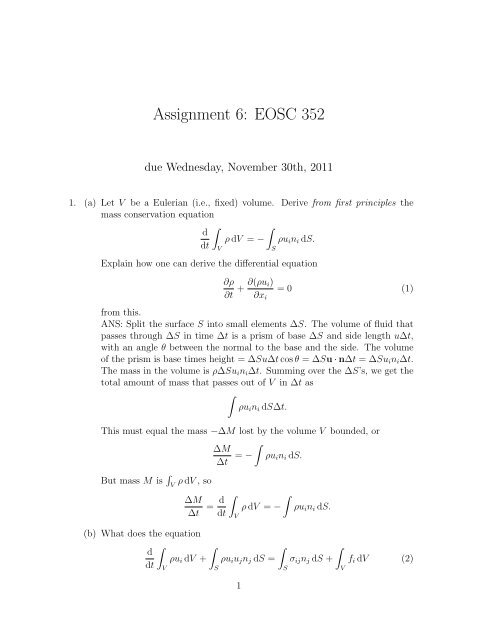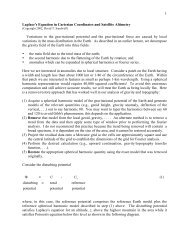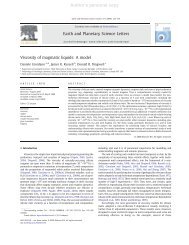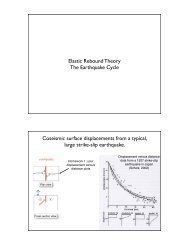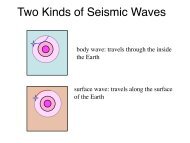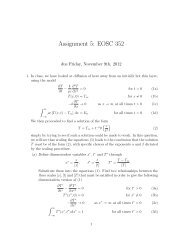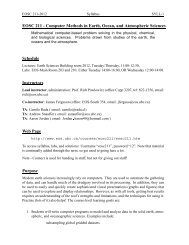Assignment 6: EOSC 352
Assignment 6: EOSC 352
Assignment 6: EOSC 352
Create successful ePaper yourself
Turn your PDF publications into a flip-book with our unique Google optimized e-Paper software.
Now V is arbitrary, so we can pick V = ∆V to be very small, and write∫∂(ρu i )+ ∂(ρu iu j )− ∂σ [ij∂(ρui )−f i dV ≈ + ∂(ρu iu j )− ∂σ ]ij− f i ∆V = 0.∂t ∂x j ∂x j ∂t ∂x j ∂x jVHence∂(ρu i )∂t+ ∂(ρu iu j )∂x j− ∂σ ij∂x j− f i = 0,and the required equatio follows from a simple rearrangement.(e) Using both (3) and the equation for mass conservation, show thatANS: Simply apply the product rule to findρ ∂u i∂t + ρu ∂u ij = ∂σ ij+ f j . (4)∂x j ∂x j∂(ρu i )∂t+ ∂(ρu iu j )∂x j= ρ ∂u i∂t + u ∂ρi∂t + ρu ∂u i ∂(ρu j )j + u i∂x j ∂t= ρ ∂u (i∂t + ρu ∂u i ∂ρj + u i∂x j ∂t + ∂(ρu )j)∂x j= ρ ∂u i∂t + ρu ∂u ij∂x jfrom the mass conservation equation above.(f) The Kronecker delta tensor is defined as{ 1 if i = j,δ ij =0 if i ≠ j,Write this as a matrix.ANS:⎛δ = ⎝1 0 00 1 00 0 1⎞⎠ .(g) The rest of this assignment is about inviscid fluids. For an inviscid fluid, thestress tensor isσ ij = −pδ ij .Explain why this assures that angular momentum is conserved.From the definition of δ ij , we getσ ij = −pδ ij = −pδ ji = σ ji ,which is the condition for angular momentum to be conserved.Page 3
For the Cartesian approach, we get∫∫ [L ∫ rρω x 2 1 + x 2 2 dV = ρωV0 −r= ρωL= ρωL∫ r2x 2 1−r∫ r−r[ ∫√r 2 −x 2 1√−r 2 −x 2 1√r 2 − x 2 1 + 2x 2 1 + x 2 2 dx 2]√2(r 2 + 2x 2 1) r 2 − x 2 1/3 dx 1dx 1]dx 3(√r 2 − x 2 1) 3/3 dx 1Now we still have to make the substitution x 1 = r sin θ, dx 1 = r cos θ dθ,with the limits x 1 = −r and x 1 = r becoming θ = −π/2 and θ = π/2,respectively. So∫ rρωL 2(r 2 + 2x 2 1)√r 2 − x 2 1/3 dx 1 = 2ρωLr4−r3= 2ρωLr43∫ π/2−π/2∫ π/2−π/2√(1 + 2 sin 2 θ) 1 − sin 2 θ cos θ dθcos 2 θ + 2 cos 2 θ sin 2 θ dθAs you can see, this is turning into rather a lot of work. It can be donehowever: we have some standard trigonometric identities:So∫ π/2−π/2cos 2 θ = 1 2 + 1 cos 2θ,22 cos 2 θ sin 2 θ = 1 2 sin2 2θ = 1 4 − 1 cos 4θ.4cos 2 θ + 4 cos 2 θ sin 2 θ dθ =∫ π/2−π/234 + 1 2 cos 2θ − 1 cos 4θ dθ2= 3π 4Substituting this finally gives the same answer again, L 12 = πρωLr 4 /2.We still have to work out L 13 and L 23 . Take L 13 first,∫L 13 = ρω(x 1 u 3 − x 3 u 1 ) dVV∫= ρω x 2 x 3 rdVVAgain, this is easiest to do in polar coordinates with x 2 = r ′ sin θ and dV =Page 5
′ dr ′ dθ dx 3 , ThenL 13 = ρω= ρω= 0∫ L[∫ 2π0[ x232] L00[∫ r]x 3 r ′ sin θ dr ′0[− cos θ] 2π0[ r′22] r0]dθ dx 3In perfect analogy with this, we can also show that L 23 = 0. So the onlynon-zero component of angular momentum is L 13 = πρωLr 4 /4.(j) For a fluid with constant density (also termed an incompressible fluid), wecan put ρ = constant into (1) to obtain a differential equation that containsu i only. Derive this equation, and express it in classical (non-subscript)vector calculus notation. Verify that the velocity field in (5) satisfies thisdifferential equation.ANS: If ρ = constant, then∂ρ∂t + ∂(ρu i)∂x i= ρ ∂u i∂x i= 0,so ∂u i /∂x i = 0. With the velocity field given above, we have∂u i∂x i= ∂u 1∂x 1+ ∂u 2∂x 2+ ∂u 3∂x 3= ∂(−ωx 2)∂x 1+ ∂(ωx 1)∂x 2= 0.(k) The x 3 -axis is vertical, and the body force f i takes the formf 1 = 0 f 2 = 0 f 3 = −ρg,where g is acceleration due to gravity. Substitute for u i , σ ij and f i in terms ofx i , p, ρ and g in (4), deriving one differential equation per index i = 1, 2, 3.These should end up taking the form∂p∂x 1= ρω 2 x 1 , (6a)∂p∂x 2= ρω 2 x 2 , (6b)∂p∂x 3= −ρg. (6c)(If I can’t tell how you arrived at these, you won’t get any marks for thispart.)ANS: Take i = 1, 2, 3 in turn. Then, for i = 1 and summing over j = 1, 2, 3Page 6
as required by the repeated index, we have, assuming a steady state withthe velocity field given above0 = ρ ∂u 1∂t + ρu ∂u 1 ∂u 1 ∂u 11 + ρu 2 + ρu 3 + ∂p − f 1∂x 1 ∂x 2 ∂x 3 ∂x 1∂(−ωx 2 ) ∂(−ωx 2 )= −ρωx 2 + ρωx 1 + ∂p∂x 1 ∂x 2 ∂x 1= −ρω 2 x 1 + ∂p .∂x 1Rearranging gives the first required equation. Proceeding the same way withi = 2,0 = ρ ∂u 2∂t + ρu ∂u 2 ∂u 2 ∂u 21 + ρu 2 + ρu 3 + ∂p − f 2∂x 1 ∂x 2 ∂x 3 ∂x 2∂(ωx 1 ) ∂(ωx 1 )= −ρωx 2 + ρωx 1 + ∂p∂x 1 ∂x 2 ∂x 2= ρω 2 x 2 + ∂p .∂x 1which gives the second required equation after some rearrangement.i = 3,For0 = ρ ∂u 3∂t + ρu ∂u 3 ∂u 3 ∂u 31 + ρu 2 + ρu 3 + ∂p − f 3∂x 1 ∂x 2 ∂x 3 ∂x 3= ∂p − ρg∂x 3Rearranging, this gives the third required equation.(l) When you have a differential equation of the form∂f∂x 1= g(x 1 , x 2 , x 3 ),where g is some given function, then, by integrating with respect to x 1 whilekeeping x 2 and x 3 constant, you find∫f(x 1 , x 2 , x 3 ) = g(x 1 , x 2 , x 3 ) dx 1 + h(x 2 , x 3 ),where h is an undetermined function of x 2 and x 3 that takes the role ofa constant of integration in ordinary differential equations. Applying thisapproach to all three equations in (6) in turn, deduce thatp = 1 2 ρω2 (x 2 1 + x 2 2) − ρgx 3 + C,Page 7
where C is a constant (i.e., C does not depend on any of the x i ).ANS: Applying the procedure above to the first equation in (6),p(x 1 , x 2 , x 3 ) = ρω2 x 2 12+ f 1 (x 2 , x 3 ),where f 1 is a function that does not depend on x 1 . Substitute this into thesecond equation in (6):∂p∂x 2= ∂(ρω2 x 2 1/2 + f 1 )∂x 2= ρgx 2 .Hence∂f 1= ρω 2 x 2 .∂x 2Applying the same approach again, we getf 1 (x 2 , x 3 ) = ρω2 x 2 22+ f 2 (x 3 ),where f 2 depends only on x 3 . Substituting p = ρω 2 x 2 1/2 + f(x 2 , x 3 ) =ρω 2 (x 2 1 + x 2 2)/3 + f 2 (x 3 ) into the third equation in (6) givesdf 2dx 3= −ρg,where we can write an ordinary derivative as f 2 depends only on one argument.Hencef 2 = C − ρgx 3 .Substituting this back into p = ρgx 2 1/2 + f(x 2 , x 3 ) = ρω 2 (x 2 1 + x 2 2)/3 + f 2 (x 3 )gives the requiredp = 1 2 ρω2 (x 2 1 + x 2 2) − ρgx 3 + C.(m) The fluid has a surface at x 3 = h(x 1 , x 2 ), i.e., at an elevation x 3 that dependson x 1 and x 2 . You are told that h(0, 0) = 0, and that pressure in the fluidat the surface x 3 = h(x 1 , x 2 ) is equal to a constant atmospheric pressure p a .Use this information to find C and to find h(x 1 , x 2 ) for general x 1 and x 2 .ANS: On the surface x 3 = h(x 1 , x 2 ). Substituting this into the equation forpressure above, we getp(x 1 , x 2 , h(x 1 , x 2 )) = 1 2 ρω2 (x 2 1 + x 2 2) − ρgh(x 1 , x 2 ) + C.But this is the pressure at the surface, and therefore equal to p a . Equating,we get12 ρω2 (x 2 1 + x 2 2) − ρgh(x 1 , x 2 ) + C = p aPage 8
orBut h(0, 0) = 0, so C = p a andh(x 1 , x 2 ) = ω2 (x 2 1 + x 2 2)2g+ C − p a.ρgh(x 1 , x 2 ) = ω2 (x 2 1 + x 2 2).2g(n) Let ω = 8π s −1 and g = 9.8 m s −2 . What is the height h of the fluid surfaceat a location for which √ x 2 1 + x 2 2 = 4 cm? Look at your household settingin part h. Is this height realistic? Could you reproduce this in a tabletopexperiment? (Get a bonus point towards your final grade for sending me adigital image of such an experiment.)ANS: We get h = (4π) 2 (0.04) 2 /(2 × 9.8) m = 1.29 cm. To reproduce this onyour table top, you have to have a mug of 8 cm diameter minimum, and youhave to be able to stir with two rotations a second, which is not unrealistic.(o) Suppose now that the fluid is still incompressible but has a finite viscosityη, so the stress tensor is( ∂uiσ ij = −pδ ij + η + ∂u )j.∂x j ∂x iShow that, with the velocity field (5), the equations (6) still hold, so you getthe same answer as before.ANS: With this velocity field, we get find that ∂u i /∂x j is only non-zero forthe following combinations of i and j:i = 1, j = 2i = 2, j = 1∂u i= ∂(−ωx 2)= −ω∂x j ∂x 2∂u i= ∂(ωx 1)= ω.∂x j ∂x 1Hence the only possible non-zero components of the tensor( ∂uiη + ∂u )j∂x j ∂x iare those for which i = 1, j = 2 and i = 2, j = 1. However, for these, theterms ∂u i /∂x j and ∂u j /∂x i are equal and opposite, so thatas before, so (6) still holds.σ ij = −pδ ijPage 9


